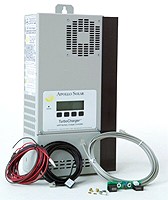While the idea of using a high input voltage charge controller is intriguing, there are some things to consider. The benefit of using a high voltage charge controller is the ability to have one long series string of solar panels wired together, or fewer strings in a system. This reduces the number of cables, reduces wire size and voltage drop issues, and reduces the number of breakers in the system for easier wiring and faster installation.

A high voltage solar MPPT charge controller
It is certainly nice to be able to series a bunch of modules together, but keep in mind that the balance of system components that are required will change from the norm. Once the temperature corrected open circuit voltage of the module string exceeds 150VDC we need to make sure that the components between the PV and controller are also rated for that voltage. Most of the DC rated breakers are rated for 150VDC which is fine for most of the controllers that have a 150VDC max input, but with higher voltage units now available these breakers are not always viable. There are some manufacturers out there that are now making 300VDC breakers to accommodate their high voltage charge controller units. These breakers are actually a combination of two 150VDC breakers, so this means that the size is equal to two breakers. So when choosing a combiner box or enclosure, it is important to keep in mind that the 300VDC breaker will be taking up two breaker spaces. One manufacturer is also manufacturing enclosures specifically for their high voltage breakers. When using a controller that has a 600VDC input, the enclosure options also get a little more expensive. One option is to use a combiner box with touch safe fuse holders and 600VDC fuses, but since the code requires both overcurrent protection and a means of disconnect, a 600VDC rated disconnect would also be required. If you are not combining any strings you could use a fused 600VDC disconnect.
So before you jump into a high voltage unit remember not to use the good ‘ol standard breakers that you are accustomed to. High voltage breakers and enclosures are a must in a system with a high voltage charge controller.

Also, while MPPT is better in *most* cases, some systems actually benefit from having multiple strings. For instance, I have a 1kw 48V off-grid DC system which is in four strings (2 panels per string). In my situation it is advantageous because we have partial shading, and so the multiple strings serve sort of the same advantage as microinverters – one string can be shaded without pulling down production for the whole array. If you’ve got a great big open sunny roof – awesome! – but on challenging sites smart system design is all the more important…
This is awesome!